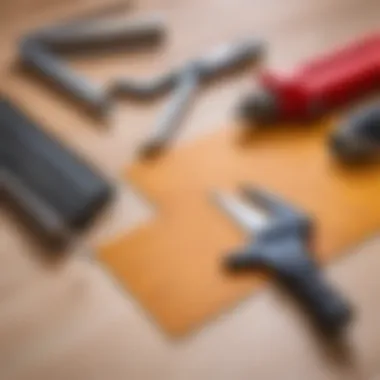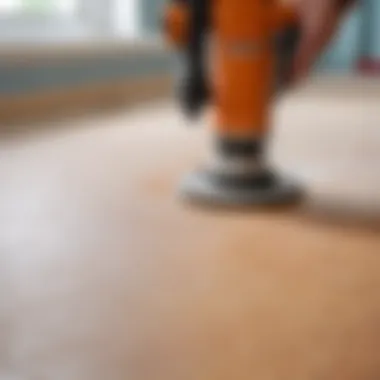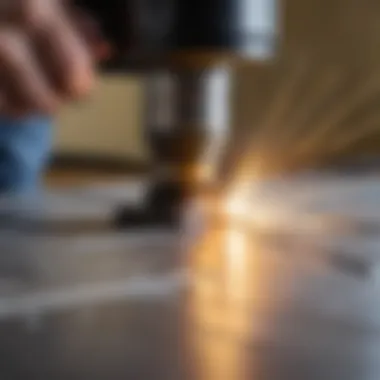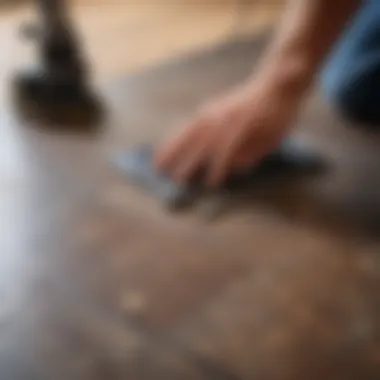Mastering Linoleum Welding: A DIY Guide


Проектирование и планирование
Before diving into the welding aspect of linoleum flooring, it's essential to lay down a solid plan. Effective project design and planning are crucial to achieve satisfying results. This involves carefully assessing the area where you intend to install the flooring, choosing the right design, and preparing accordingly.
Как выбрать проект для DIY
When selecting a DIY project for welding linoleum, consider the size and layout of the space involved. Understanding the dimensions helps determine how much material is required. Additionally, think about the patterns and colors that will complement your space. It may assist you to sketch or use design software to visualize the placement before initiation.
To conduct a successful project, it's also vital to evaluate your skill level and the complexity of the tasks required. Do not choose a project that exceeds your capabilities, as this can lead to discouragement and poor results. A good rule of thumb is to start small, perhaps with a bathroom or a small kitchen area, before moving on to larger spaces.
Оценка времени и ресурсов
Time management is another key component when planning your linoleum welding project. On average, a small area might take several hours, including prep work and installation. For larger or more intricate layouts, it is wise to allot several days to complete the installation.
Consider your resources: the necessary tools, materials, and your own availability. Make a list of items you will need, such as:
- Welded linoleum sheets
- Welding rod
- Utility knife
- Straight edge
- Heat welding tool
- Safety gear (gloves, goggles)
By preparing adequately, you enhance the chances of a flawless installation.
Выбор материалов
Selecting the right materials is essential for the durability and appearance of your linoleum flooring. Not all linoleum is created equal; some types are better suited for high-traffic areas, while others may be more stylish for aesthetic appeal.
Типы материалов для различных проектов
Linoleum comes in various types, each with distinct characteristics. For instance:
- Standard linoleum: Great for most residential and commercial applications.
- Commercial-grade linoleum: More durable and resistant to wear and tear, suitable for high-traffic zones.
- Eco-friendly linoleum: Made from natural materials, ideal for sustainable projects.
When exploring your material options, consider not just aesthetics but also functionality and safety regulations relevant to your environment.
Советы по покупке и экономии
When it's time to purchase materials, shop around for the best prices. Take advantage of sales and discounts offered by local home improvement stores. Online retailers may also provide competitive rates. Consider buying slightly more material than you estimate needing. This helps accommodate mistakes or miscalculations without requiring a return trip to the store.
Understanding installation practices, combining efficiency with quality, and choosing suitable materials are vital steps in ensuring your linoleum welding project is successful.
Preamble to Linoleum Welding
Welding linoleum flooring is a skilled task that carries significant importance in flooring installation and repair. Understanding the subtleties of this technique ensures that the linoleum adheres properly, creating seamless surfaces that enhance both the aesthetic and functional aspects of a space. This process is essential for DIY enthusiasts aiming to achieve professional-quality results without relying on outside help. Learning to weld linoleum equips homeowners, builders, and designers with the ability to tackle projects confidently, avoiding common pitfalls that can lead to unsightly seams and premature wear.
Understanding Linoleum as a Material
Linoleum is composed of natural materials such as linseed oil, cork dust, and wood flour, combined with pigments and a jute backing. This unique blend renders linoleum a highly durable flooring option, celebrated for its resilience and variety in colors and patterns. One notable characteristic of linoleum is its ability to be welded, forming watertight seams that can be smarter than traditional floor coverings. The thermal properties of linoleum during the welding process allows heat to fuse adjoining pieces, which creates a unified flooring surface. Even though linoleum is often considered outdated, its resurgence in modern interiors speaks volumes about its durability and sustainable nature.
Benefits of Welding Linoleum
Welding linoleum provides multiple advantages that can significantly enhance the longevity and appearance of flooring installations. Here are some benefits to consider:
- Seamless Appearance: Welding results in clean, smooth joints that minimize visible seams, giving the floor a polished look.
- Increased Durability: The welded seams are less prone to lifting, separating, or fraying, making the floor more resistant to wear and damage.
- Water Resistance: This technique creates a waterproof seal between linoleum sheets, which is vital in high-foot traffic or moisture-prone areas such as kitchens and bathrooms.
- Minimal Maintenance: A properly welded linoleum floor requires less maintenance over time, resulting in cost savings for the homeowner.


Overall, mastering the technique of welding linoleum is invaluable for any DIY enthusiast. By familiarizing oneself with the material and its properties, as well as the welding process itself, one can assure a project that holds up against daily use while also looking appealing.
Essential Tools and Materials Required
Having the proper tools and materials is essential for successfully welding linoleum. Without the right equipment, the process can become cumbersome and lead to unsatisfactory outcomes. Each tool plays a critical role in ensuring quality workmanship and efficiency. Additionally, choosing the suitable material impacts the overall aesthetics and durability of the finished surface.
List of Tools for Linoleum Welding
The tools required for welding linoleum vary based on the specific techniques one will employ. Here are some important tools to consider:
- Hot Air Welder: This is the primary tool for welding linoleum. It heats the welding rod and linoleum edges, allowing them to fuse together solidly.
- Welding Rods: These are specially formulated rods used to create the seams between linoleum sheets. Choosing the right diameter is crucial for strength and adherence.
- Straightedge or Level: A straightedge helps in making precise cutting motions. Keeping edges straight ensures a neat seam.
- Utility Knife: This tool is essential for cutting linoleum accurately. A sharp blade will reduce fraying and ensure clean edges.
- Trowel and Roller: These tools assist with applying adhesive for linoleum sections before welding. They ensure the sheets adhere correctly to the subfloor.
Having these tools on hand can streamline the welding process and lead to a better end product.
Choosing the Right Linoleum Material
Selecting the appropriate linoleum material is a fundamental aspect of the welding process. Linoleum comes in various types and finishes, and your choice greatly influences the durability and aesthetic appeal of your flooring.
- Thickness: Linoleum typically comes in thicknesses of 2mm to 5mm. Thicker materials are often more durable but may require more effort to weld precisely.
- Sheet vs. Tile: Linoleum can be found in large sheets or tiles. Sheets often allow for fewer seams, resulting in a more consistent look and less risk of seams failing. Tiles offer more design flexibility.
- Color and Design: Choosing a color and pattern that fits well with your interior design vision is vital. Linoleum can be very versatile in this aspect, providing many options.
When selecting linoleum, consider the environment where it will be installed, including foot traffic and exposure to moisture.
Other Required Supplies
Beyond the primary tools, several additional supplies are necessary to achieve a successful weld.
- Contact Adhesives: These are important for securing linoleum sheets to the subfloor before welding.
- Cleaning Supplies: A cleaner specifically designed for linoleum helps to prepare surfaces before beginning the welding process. Keeping surfaces dirt-free ensures a strong bond.
- Measuring Tools: A measuring tape ensures accurate cuts and alignment, minimizing waste and ensuring that pieces fit well together.
- Personal Protective Equipment (PPE): Safety glasses and gloves are recommended to ensure protection during welding. The materials involved can be hazardous without the proper precautions.
Ensuring you have all necessary supplies simplifies the process and can improve the quality of your welding.
"Proper preparation is key in any DIY task, especially when it comes to welding linoleum. The right tools and materials make all the difference in achieving flawless results."
Preparing the Surface for Welding
Preparing the surface for welding linoleum is a crucial step that significantly impacts the quality and durability of the finished flooring. Proper preparation ensures that the linoleum adheres well, minimizing the risk of future damage and enhancing the aesthetic appeal of the area. Ignoring this step can lead to uneven surfaces, which may ultimately result in seams that lift or gaps appearing over time. An adequately prepared surface provides a solid foundation for the welding process, facilitating a smooth application and secure bond.
Cleaning and Leveling the Subfloor
Before beginning the welding process, it is essential to clean and level the subfloor. The subfloor should be free of any debris, dust, or contaminants, as these can interfere with the adhesion of the linoleum. Start by sweeping or vacuuming the area thoroughly.
If necessary, wash the floor with a mild detergent and water, ensuring all residue is rinsed off completely. Once cleaned, it's crucial to check for any unevenness in the subfloor. An uneven surface can result in improper fitting of the linoleum pieces, leading to potential issues after installation. Utilizing a leveling compound may be required to fill in low spots, creating a flat and even base for the linoleum.
Measuring and Cutting Linoleum Correctly
Accurate measurement and cutting of the linoleum are vital for ensuring that the pieces fit together seamlessly. Begin by measuring the area where the linoleum will be installed using a tape measure. Mark the measurements clearly on the linoleum sheet.
When cutting, use a straight edge to guide your utility knife. It is advisable to cut slightly larger than the marked line as slight adjustments can often be made on-site to ensure a perfect fit. This method minimizes the chance of undercutting, which can create gaps in the seams. Once cut, lay out the pieces on the subfloor without fastening them to check that everything fits as required.
Aligning Pieces Before Welding
Proper alignment of linoleum pieces before welding is crucial for achieving a professional finish. Start by gently placing the cut pieces on the subfloor, ensuring they fit snugly against each other. Use a square or level to ensure that edges are straight and that the linoleum aligns properly with adjacent pieces.


Make any necessary adjustments at this stage, as it will be much more difficult to correct misalignments once the welding process begins. Ensure that any patterns or designs on the linoleum line up across seams for a cohesive look.
By meticulously preparing the surface, you set a strong foundation for successful linoleum welding, which contributes to the overall results in aesthetics and durability.
Techniques for Welding Linoleum
Welding linoleum may seem daunting to some, but understanding the techniques involved is essential for achieving a seamless finish. This section covers practical methods and processes that will facilitate efficient welding, which is critical to ensuring structural integrity and aesthetic value of linoleum floors. Proper knowledge of welding techniques can lead to fewer errors and a durable installation.
Overview of Welding Methods
Several methods exist for welding linoleum. Among the most common are hot air welding and extrusion welding. Each of these methods serves a distinct purpose and offers different benefits.
- Hot Air Welding: This method utilizes a hot air tool to melt the edges of the linoleum sheets, allowing them to fuse together. It's often favored for its precision and effectiveness on various surfaces.
- Extrusion Welding: Here, a welding rod is fed into a welding gun which heats and applies the rod into the joint. This technique is useful when working with thicker materials.
Understanding these methods allows the DIY enthusiast to choose the right approach for their specific project based on material type and required strength.
Step-by-Step Welding Process
The welding process requires diligence and attention to detail. Here are the three core actions involved in successful linoleum welding:
Heating the Welding Tool
Heating the welding tool is one of the first steps in this process. It is crucial to achieve the right temperature before you start any welding. The ideal temperature range is typically between 350°F to 375°F. Ensuring the tool is sufficiently heated contributes to an even application of the weld material, avoiding weak points in the weld.
A well-heated tool permits quicker fusion, leading to a better finish with reduced risk of damage to the linoleum. However, overheating can cause warping, which is a downside to watch out for.
Applying Weld Rods
Applying weld rods correctly is a vital part of the welding process. The weld rods are specifically formulated for linoleum and must be chosen based on the color and type of linoleum being used. Inserting the rod into the welding tool allows it to melt and fill the joint. A steady hand and consistent movement help to ensure the weld is uniform.
The benefit of using weld rods is the strong bond it forms between the linoleum sheets. However, it is critical to maintain the proper speed in applying them; too slow can result in excess material while too fast may lead to gaps.
Sealing the Joints
Sealing the joints completes the welding process. Once the weld has been applied, it needs to cool and set properly. Allowing sufficient curing time leads to stronger seams. A cool environment can aid in this process. Additionally, reheating the sealed joints lightly can help to ensure durability.
This step is essential for overall appearance and functionality of the floor. A well-sealed joint prevents dirt and moisture from penetrating, prolonging the life of the linoleum. Conversely, improper sealing can lead to premature wear.
Common Mistakes to Avoid
Successfully welding linoleum requires attention to detail. Here are some typical mistakes that novices often make:
- Ignoring Surface Preparation: Not properly preparing the surface can weaken the bond.
- Incorrect Temperature Settings: Too high can damage the linoleum while too low won't result in proper fusion.
- Rushing the Application: Consistency and patience are key to a clean finish.
Proper techniques lead to a finished product that is durable and visually appealing.
Post-Welding Maintenance and Care
After completing the welding of linoleum, it is essential to understand and implement proper maintenance and care. These steps directly influence the longevity and aesthetic appeal of your flooring. After all, the quality of linoleum welding is only as good as the care it receives afterward. This section discusses key aspects that should be addressed to ensure the integrity of your work.
Curing and Setting Time


Curing and setting time is a fundamental consideration post-welding. Upon finishing the welding process, the weld material needs adequate time to solidify. Typically, the curing period will vary based on the specific materials used and the environment. A common recommendation is to allow at least 24 hours for the joint to cure effectively. During this time, refrain from subjecting the weld to heavy loads or traffic. This waiting period is crucial in ensuring that the weld bonds securely with the linoleum. Gradually introducing weight can help maintain stability as the weld continues to cure fully.
Cleaning Up After Welding
Post-welding cleanup has a significant role in maintaining linoleum quality. Removing excess welding material and any debris is important. Use a soft cloth or a plastic scraper to gently clean the surface. Avoid abrasive tools as they may damage the linoleum. Additionally, it's essential to properly dispose of any waste material according to local regulations. Ensuring a clean workspace not only enhances the appearance but also contributes to the longevity of the weld. Regular cleanups help in preventing dirt from accumulating, which can lead to eventual wear and degradation of the weld area.
Regular Maintenance Tips for Longevity
To maximize the lifespan of your welded linoleum, consider these maintenance tips:
- Avoid Excess Moisture: Regularly check for water accumulation, especially in high-humidity areas. Excess moisture can weaken joints and promote mold growth.
- Routine Inspections: Conduct routine inspections to identify any wear or damage to the welded seams. Early detection can prevent more significant issues down the line.
- Gentle Cleaning Products: When cleaning, opt for mild detergents instead of harsh chemicals. Strong cleaners can deteriorate the weld over time.
- Protective Coatings: Consider applying a protective coating to the linoleum surface. This can help resist scratches and stains, thereby preserving its original look.
- Report Issues Promptly: If you observe any changes or issues with the weld, address them immediately. Early intervention is often more manageable and cost-effective than letting problems worsen.
Regular attention to these aspects ensures that your welded linoleum remains in optimal condition. This guarantees not only functionality but also enhances visual appeal in any interior design.
Safety Precautions During the Welding Process
Safety is paramount when welding linoleum due to the materials and tools involved. This section discusses key aspects that provide a protective environment during the welding process. Understanding safety measures not only protects the individual but also ensures a successful welding project.
Personal Protective Equipment (PPE)
Using proper Personal Protective Equipment is crucial when welding linoleum. The equipment protects against potential hazards like heat, fumes, and sharp edges. It is recommended to wear the following items:
- Safety goggles: Protect your eyes from harmful fumes and debris.
- Heat-resistant gloves: These prevent burns from hot surfaces.
- Long-sleeved clothing: Wearing long sleeves shields your skin from sparks and sliding tools.
- Respirators: While not always necessary, a respirator can provide additional protection against smoke and fumes especially in non-ventilated areas.
- Steel-toe boots: These protect your feet from falling equipment or heavy tools.
By utilizing PPE, you mitigate the risks and focus more on the welding procedure itself. Always inspect your PPE for wear and tear before starting work. A compromised equipment can fail at crucial moments.
Ventilation Requirements
Adequate ventilation is essential during the welding process of linoleum. Welding produces fumes that can be harmful when inhaled over time. Good airflow significantly reduces the concentration of harmful substances in the air and prevents the build-up of toxic fumes. Here are some considerations for ensuring proper ventilation:
- Work in open spaces: If possible, carry out welding in an outdoor environment. This allows for natural airflow and decreases the risk of inhaling fumes.
- Use fans or exhaust systems: If the work area is closed, fans can help direct fumes away from the breathing zone. Ventilation systems can pull in fresh air and exhaust contaminated air out.
- Take regular breaks: If in a poorly ventilated area, take breaks frequently. This allows fresh air into your lungs, reducing potential dizziness or discomfort.
As an additional measure, always read the safety data sheets of the materials being used. These sheets provide information on hazards and necessary precautions.
Remember: Prioritize your safety and the safety of others. The right preparation can make a significant difference in the welding experience.
Finale
Finishing your project involves a careful look back at what you have learned. This article has laid out the key steps involved in welding linoleum flooring. The process is not simply about joining materials; it encompasses the entire journey from preparation to maintenance. Understanding the importance of each stage helps ensure durability and functionality of your linoleum flooring.
Recap of Key Points
To summarize, here are the critical elements we discussed:
- Understanding Linoleum: Recognizing the type of material you work with is vital. Having the right linoleum can impact the outcome.
- Tools: Proper tools are necessary. A welding gun, weld rods, and essential safety gear form the basis of your toolkit.
- Preparation: A clean and leveled subfloor is crucial. Cutting and aligning the linoleum before welding helps maintain precision.
- Welding Techniques: Familiarity with various welding methods allows you to select the most suited for your project.
- Post-Welding Care: Following guidelines for curing and maintenance enhances the lifespan of your flooring.
Each phase plays a significant role in achieving a quality outcome.
Encouragement for DIY Enthusiasts
For those who thrive on do-it-yourself projects, welding linoleum is an achievable goal. With practice, your skills will improve. Don't hesitate to take on challenges, as they contribute to your growth and experience.
Consider starting small with less visible areas to build confidence. By employing the methods outlined in this guide, you empower yourself to create professional and lasting flooring solutions. Your capabilities in home improvement expand as you familiarize yourself with various techniques and tools.
"Every successful DIY project enhances not just the space you inhabit, but also your skills and confidence."
Welding linoleum is rewarding, blending creativity with practicality. Embrace the journey, and soon you will see the benefits firsthand.







